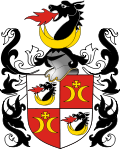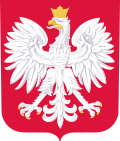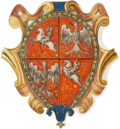| Ostoja | |
|---|---|
 | |
| Battle cry | Hostoja, Ostoja |
| Alternative name(s) | Hostoja, Mościc, Ostojczyk |
| Earliest mention | 1232 (seal of Nicolaus Ostoja de Stiboricz) |
| Families | 205 names Ancient lines - 150 Lords of Ostoja Balicki, Bańkowski (Bankowski), Baliński, Banczelski, Baranowski, Bartkowski (Bartoszewski), Bąduski, Bątkowski, Bębnowski, Biel, Bielski, Bieńkowski, Biestrzykowski, Blinowski, Błaszkowski, Błociszewski', Bobinski, Bogusławski , Boguszewski , Borowieski, Bratkowski, Brokowski, Broniowski, Bzowski, Bukowski, Chechelski Chełmski, Chocienski, Chodorkowski, Chotkowski, Chrostowski, Chrościcki, Chrząstowski, Chyżyński (Chyżewski), Ciechański, Cieszęcicki, Cieśliński, Czernikowski, de Gord, Dembowski (Dębowski), Dmosicki (Dmościcki), Dmuszewski, Dubaniewski (Dobaniowski), Dubikowski , Dobromirski, Domaradzki (Domaracki), Dudkowski (Dutkowski), Dulowski, Dzieczyński, Gajewski , Gawłowski, Glewski, Głazowski (Głazewski), Głębocki, Głodowski, Głogiński , Gniady, Godziszewski, Gorkowski, Halczyński, Ilikowski, Iłowiecki , Iwański, Jackowski, Jajkowski (Jaykowski), Janikowski, Janiszewski, Jański, Jerzykowski, Kamieński, Karabczewski (Krabczyjowski, Karapczewski), Karliński, Kaweczyński (Kawieczyński), Kiedrowski, Kiedrzyński, Klonowski, Kobylski, Komorowski, Kondradzki (Kondracki), Kośniewski, Koźniewski (Kożniewski), Kowalkowski, Kreza, Krępski (Kempski), Książnicki, Kropidła, Krzelczycki (Krzylczycki), Krzyczkowski, Krzywicki, Latkowski, Leksycki, Leski (Lenski, Łęski), Lniski , Łowiecki (Łowicki), Lubicki, Lubiatowski, Lubochowski, de Łopuszna, Łuczanowski, Łukowicki, Maleczkowski, Marchocki, Markiewicz (Markowicz), Marylski, Niedzwiedzki (Niedzwiecki, Miedzwiecki), Mietelski, Mioduszewski , Modrzejowski (Modrzejewski, Modrzewski), Mościcki, Nagórski (Nagorski), Olewiński (Oliwiński), Osieczkowski (Osiczkowski), Ostaszewski , Ostojski, Owsiany, Oziębłowski, Pęgowski, Pękowski, Piaszczyński, Pilawski, Podwysocki, Politalski (Politański), Poniecki, Potocki, Postrumieński, Radogowski (Radogorski), Raduński, Rokosz (Rekosz), Roguski , Rożniatowski, Ryk, Rylski , Rysiński, Sarbski, Sędzimir (Sendzimir), Siedlecki, Sieradzki, Skórka, Skrzyszewski (Skrzyszowski, Skrzeszewski), Słoński, Smuszewski (Smoszewski), Solecki , Stachorski (Stachurski, Stachera), Starzewski (Starzeski), Staszewski, Stobiecki, Strzałkowski (Strzałka), Suchorabski (Suchorębski), Świerczyński (Swierczyński), Ściborski, Szyszkowski, Targoński , Teliński, Turznicki (Turnicki), Unichowski, Wadowski, Woynowski, Zabierzowski, Zaborowski (Zborowski), Zagórski (Zagorski, Zagurski), Zajarski (Zajerski), Zakobielski, Żelisławski. Contents
Ancient Lithuanian and Ruthenian lines of Ostoja - 23 Lords of Ostoja: Ancyparowicz , Błyszczanowicz, Boratynski, Brodowicz , Czechowicz, Czeczot, Danielewicz (Danilewicz), Darowski, Hrebnicki Doktorowicz , Gajdowski-Potapowicz , Kaczanowski, Karlewicz, Krzywiec (Okołowicz), Kublicki (Piottuch-Kublicki), Kumanowski, Kurosz, Mokrzecki, Nieradzki, Palecki, Pietrzkiewicz (Wadowski-Pietrzkiewicz), Raczko , Słuszka, Tumiłowicz . Other verified lines - 32 families: Bohatyrewicz (Bohatyrowicz), Bochuszewicz, Chudziński (Chudzyński), Dworzecki (Dworecki, Dworzecki-Bohdanowicz), Głowczewski (Kłopotek-Głowczewski), Gołąbek-Kowalski, Grądzki, Hełczyński, Jakliński, Jotejko (Joteyko), Kałłaur, Kątkowski (Kontkowski), Kotnowski, Kozłowiecki, Lubochoński (Lubochiński), Miklaszewicz (Mikłaszewicz), Miklaszewski , Mikorski, Ochocki, Piestrzecki, Podgorski, Raczewski, Rudziecki, Rumszewicz, Samborski, Samorok (Samorak, Sumorok), Siedlikowski, Siedliski, Siemoński, Starzycki, Suchcicki, Ulejski (Uleski) Not verified lines - 29 families: Barankiewicz (tatar origin), Bociarski, Bogorajski - nob, Bohuszewicz (Boguszewicz), Chodkowski, Chrostecki, Chrostowski, Duczman, Duszakiewicz, Gajewicz, Glindzicz, Gołębiowski, Hulanicki, Juckiewicz, Kończycki, Krall - nob, Mikutowicz, Modliszewski, Nagórczewski, Nagorski - nob, Nyko (Nyka, Nyk), Osiejewski, Ostaniewicz, Palczyński, Pankiewicz, Siemienowicz, Stackiewicz, Stebelski, Trzecieniecki Not verified and most probably not belonging to the Clan of Ostoja - 77 families: Bardecki, Bęczelski, Biestrzecki, Błoszczyński, Chełmowski, Chocimowski, Chotkowicz, Chudzicki, Czapiewski, Domontow, Dreling, Dulski, Elżanowski, Glokman, Gralewski, Hajewski, Hubnicki, Jakowicki, Kargowski, Kasprzycki, Kleczewski, Kłębowski, Kołodziejski, Konczyński, Krzelewski, Lutomirski, Mokrzewski, Mosalski, Nasierowski, Nass, Nos, Ochocimski, Oczepowski, Orda (Ordyniec, Ordyński - tatars of Orda Coa), Osiecki, Ostanowski, Ostarzewski, Ostaszewicz, Ostyłowski, Przeszmiński, Raduński (tatar, extinct), Rafalski, Raszewski, Redej (Rhedey), Rozkoszewski, Rudołtowski, Rzepliński, Rzymczykowski, Słupski, Stachelski, Steblecki, Strzelecki, Sułecki, Szczoskowski, Szmigłowski, Szyszko, Trzebnicki, Tucznia, Tołkacz, Tomkiewicz, Turkułł, Tworowski, Ubliński, Ustarbowski, Wasilewski, Wojtkiewicz, Woyszyk, Wyrzek, Wróblewski, Zabokrzycki, Zakrzewski, Zarogowski, Zasztowt, Zębedey, Zdaniszewski, Złoszcz. |
| Cities | Konstantynów Łódzki, Terespol, Skierbieszów |
Ostoja is a Polish coat of arms that probably originated from Sarmatian Tamga [1] [2] and refer to Royal Sarmatians using Draco standard. Following the end of the Roman Empire, in the Middle Ages it was used by Ostoja family in Lesser Poland and later also in Kujavia, Mazowsze and Greater Poland. [3] It is a coat of arms of noble families that fought in the same military unit using battle cry Hostoja or Ostoja, and that applied their ancient heritage on the coat of arms, forming a Clan of knights. Later, when the Clan expanded their territory to Pomerania, Prussia, Slovakia, Hungary and Romania they also adopted a few noble families of Ruthenian origin that in 14-15th century settled down in Lithuania, Belarus and Ukraine, finally turning into the Clan of Ostoja. As different lines of the clan formed surnames after their properties and adding the adoptions, Ostoja was also recognized as CoA of several families that was not necessary connected to the original Clan, forming Heraldic clan. [4] [5] [6]


































